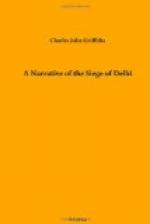[Footnote 6: On August 7 they blew up one of their own powder factories, and with it a number of workmen.]
CHAPTER IV
CAPTURE OF THE CITY
The actual Siege of Delhi may be said to have commenced on September 7, 1857. All reinforcements that could possibly arrive had reached us with the siege-train, and the effective force now available for operations before Delhi consisted of the following troops:
European artillery 580
" cavalry 514
" infantry 2,672
-----
3,766
Native artillery 770
" cavalry 1,313
" infantry 3,417
Engineers, sappers, miners, etc.
722
-----
6,222
-----
Grand total 9,988
To the above must be added the Kashmir contingent of 2,200 men, with four guns, and the cavalry of the Jhind Rajah, perhaps 400 more, making the full amount of troops employed at the siege 12,588.
The seven regiments of European infantry were sadly reduced in numbers, being mere skeletons, the strongest mustering 409 effective rank and file, and the weakest only 242. There were also nearly 3,000 men in hospital, Europeans and natives.
From the most reliable sources the enemy at this period numbered 40,000 men, all trained soldiers of the former regular army, besides undisciplined armed hordes of fanatics and rabble of the city and surrounding country—a formidable disproportion to our scanty force when it is recollected that they were protected by strong fortifications mounting upwards of fifty guns, with an unlimited supply of artillery and munitions of war, and that with their vast numbers they had ample opportunities of harassing our right flank and rear and cutting off communications up-country.
Nevertheless, political considerations demanded that we should take the offensive and deal such a blow as would convince the rebels, as well as those whose loyalty was wavering, that the British arms were irresistible. Moreover, there was no likelihood of our force being increased. So on September 7 General Wilson issued the following address to his troops:
“The force assembled before Delhi has had much hardship to undergo since its arrival in this camp, all of which has been most cheerfully borne by officers and men. The time is now drawing near when the Major-General commanding the force trusts that its labours will be over, and it will be rewarded by the capture of the city for all its past exertions, and for a cheerful endurance of still greater fatigue and exposure. The troops will be required to aid and assist the Engineers in the erection of the batteries and trenches, and in daily exposure to the sun, as covering parties.




